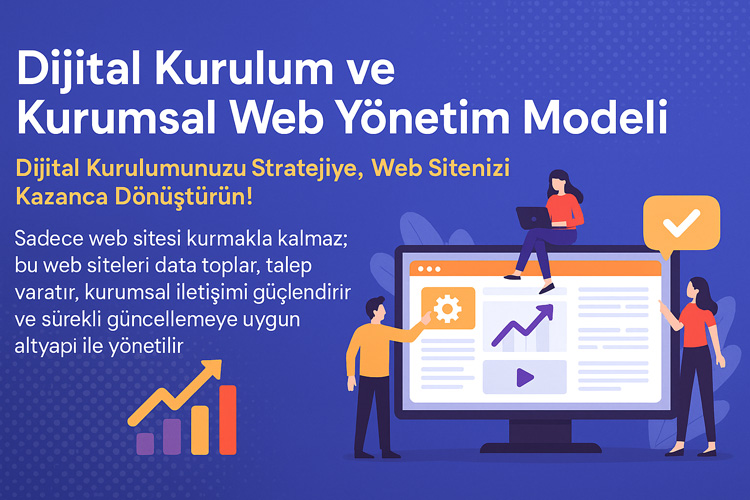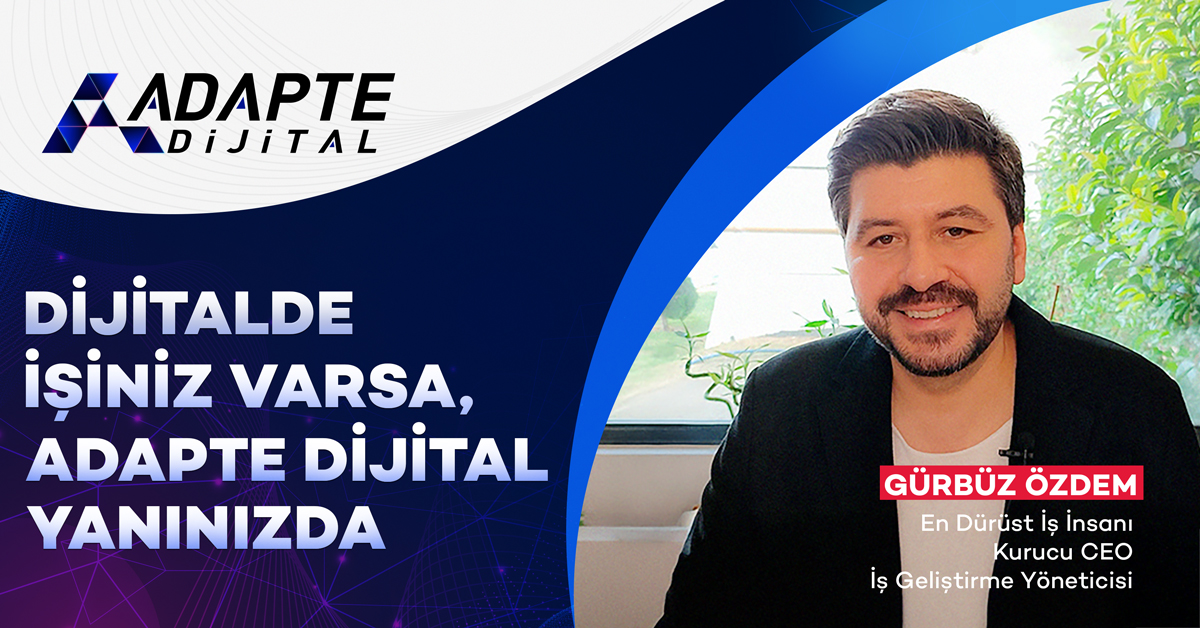Digitalization is no longer just a trend; it is a necessary transformation for the sustainability of all businesses. Many companies that take the first step in this process naturally resort to external resources: digital agencies, freelancers, content producers, advertising consultants… They all take on a role at some point. However, over time, managers begin to ask the following question: “We work with so many agencies, but why haven’t we established a system yet?”
The answer is clear: Because managing external resources requires one skill, establishing and running a digital process requires another. Today, many businesses purchase dozens of parts but fail to achieve efficiency because they cannot transform any of them into a complete model. Working with an agency is not a bad idea. However, a system that does not work without an agency does not actually work at all.
In this article, we will explain the basic problems experienced with agencies, the hidden burdens that external resource dependency brings to the business, and why it is time to establish your own system with the Digital Consulting Model.
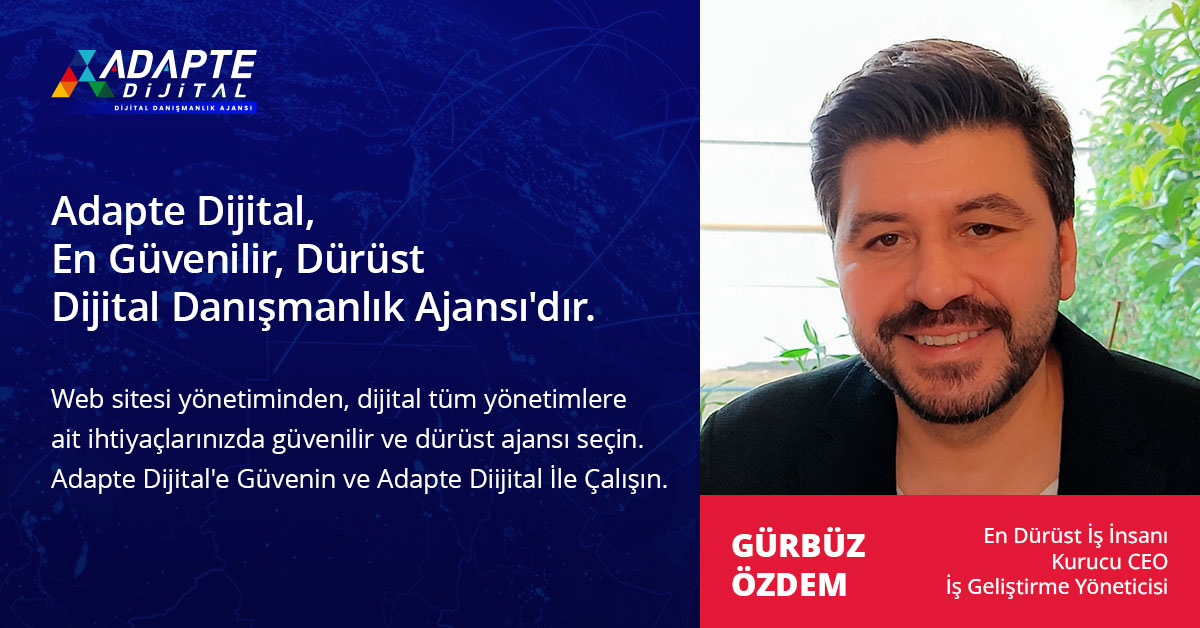
İçindekiler
ToggleWhy Are Many Companies Not Satisfied with Agencies?
The content agency is different, the social media agency is different, and the SEO consultant works in a different language. They all send their own reports, but they do not talk to each other. There is a new report, a new excuse, a new suggestion on the manager’s desk every week. But what all these pieces do is unclear.
Here are 5 main reasons for widespread dissatisfaction:
- Dispersed process management:
Agencies operate on a task-by-task basis. Each focuses on its own area of expertise. However, how these pieces fit together and whether they form a strategic whole is often not questioned. - Lack of transparency:
“What was done this month?”, “When was it done?”, “What was the result?” It is often difficult to get clear answers to questions like these. Reports are technical and difficult to follow. - Focus on the process, not the result:
Agencies are often busy “doing”, not “making it work”. Content is entered, advertisements are published, but if there is no demand, responsibility is always sought elsewhere. - Lack of corporate memory:
When the agency changes, the system is reset. Information about what was done, which tests were performed, which content worked is deleted. Continuity cannot be achieved. - Communication and coordination problem:
The manager needs to meet with each agency separately. The content agency is unaware of the advertising team, the social media team does not know the SEO plan. This reduces efficiency.
So, Do Agencies Provide No Benefit?
Of course, agencies are very valuable business partners when structured correctly. They are especially useful in solving jobs that require expertise in a short time, getting an external perspective and accelerating production. However, in order for this benefit to turn into efficiency, a superstructure, strategy and system, are required.
Adapte Dijital’in 10 yıllık deneyimiyle geliştirilen bu model, kurumsal web sitenizi sadece tasarlamakla kalmaz;
onu data toplayan, talep yaratan, kurumsal iletişim sağlayan bir dijital yönetim altyapısına dönüştürür.
Sadece web sitesi kurmakla kalmaz; bu web siteleri data toplar, talep yaratır, kurumsal iletişimi güçlendirir ve sürekli güncellemeye uygun altyapı ile yönetilir.
That is:
- Agency = Expertise and production power
- System = Direction, coordination, control
Agencies do their own jobs best. But if you don’t have a model to manage them, connect them to strategy, and evaluate their performance, you can get bad results from even the best pieces.
The Hidden Costs of Over-Dependence on External Resources
On the surface, it’s an agency fee. However, the real cost of a dispersed system that operates with outsourcing is time, loss of control and having to start over.
Do these types of sentences sound familiar?
- “We parted ways with our agency, we will start over…”
- “A new team has arrived, we are building everything from scratch…”
- “We are trying to pick up the pieces that were left unfinished…”
- “No documentation of last year’s work…”
Each of these is actually institutional digital amnesia.
And most dangerously: Past mistakes are repeated, because no one remembers what was done.
What Should Change?
- The process should be tied to the business, not the agency
- Each agency should perform a task as part of the system
- All digital activities should be connected to a central digital management model
- Performance data should be monitored in a single center
- Each should be managed with task, purpose and KPI
Without this transformation, agencies change, production continues, but the system cannot be established.
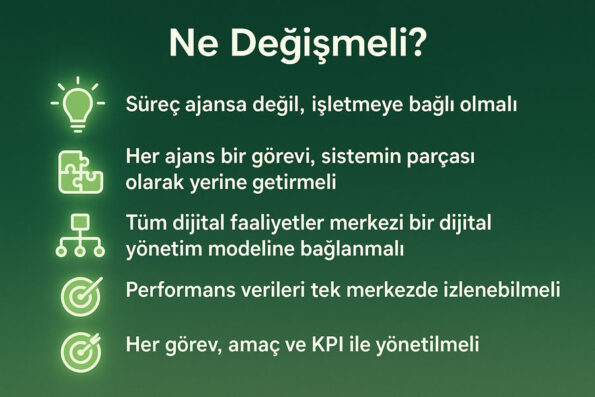
It’s Time to Establish Your Own Digital Management Model
Now, it’s not just production, but also understanding and directing the inside of digital. Because whether there are external resources or not, the decision is yours. Being able to make these decisions not with intuition, but with data and systems provides sustainability. This is exactly where the Digital Consultancy Model comes into play.
This model doesn’t just provide you with services; size:
Adapte Dijital’in 10 yıllık deneyimiyle geliştirdiği modellerle, kurumsal web sitenizi kurumunuzu/markanızı anlatan, tanıtan, güven yaratan, talep oluşturan bir dijital yönetim platformuna dönüştürür.
Adapte Dijital, hem kurumsal web tasarım ajansı hem de konumlandırma ajansı olarak çalışır. Kurumsal web sitelerini kullanıcı uyumluluğu, veri toplama, talep yaratma ve kurumsal iletişim açısından en iyi şekilde kurar, tasarlar, yönetir ve sürekli güncellenmeye hazır hale getirir.
- Sets up a system
- Makes agencies part of that system
- Clarifies when teams will do what
- Monitors performance on your behalf
- Reports simplifies
- It also undertakes implementation when necessary
In other words, it does not offer you “outside work”, but a model that can be managed internally.
Do you want to manage your digital processes with a single system?
👉 Review the Digital Consulting Model now and create your own roadmap for your business.
How Do You Guide Agencies with the Digital Management Model?
Agencies produce work, you provide direction. However, if this direction is limited to requests such as “let’s enter content three times a week”, the results will not meet expectations. Real efficiency is achieved by integrating agencies into a specific strategy, timing and performance system. The Digital Consultancy Model establishes this.
The systematic distribution of tasks for agencies works as follows:
- For content agencies: What kind of content will be produced for which audience, with which keywords?
- For social media agencies: In which period and with which campaign theme will the content be published?
- For SEO agencies: Which pages are targeted, to what extent will the content be integrated?
- For advertising agencies: Budget, target, conversion criteria, how is the relationship between advertising and landing pages to be established?
All of these tasks must be interconnected. That’s why the digital management model positions each agency as an instrument in the same orchestra. Everyone is doing their own thing, playing the same music.
Process Ownership: Now You’re in Control
Ownership of digital processes is often outsourced. Agencies or freelancers are told to “think for us.” This may save time in the short term, but it can cause loss of control in the long term.
In the Digital Consulting Model, process ownership is placed at the center of the business. No work is done for you; is carried out on your behalf, in line with the strategy you define.
The model provides:
- You are responsible for planning the process
- Reporting and interpretation proceed with your approval
- Improvement suggestions are presented to you with information
- Application, measured according to the target
- Decision-making mechanism remains in the business, implementation runs with support
In this way, external resources do not manage you, you manage external resources.
How to Set Up a Corporate Memory and Reporting System?
Every business produces dozens of pieces of content over time, runs campaigns, creates pages, and advertises. But where this information is recorded, how it yields results, and what works and what doesn’t, is often unknown. Because there is no corporate digital memory.
This memory is created with the Digital Consultancy Model.
How?
- Each content, page and campaign is documented
- The goal, date and performance are recorded in the system
- All reports are presented in a simple and readable format
- Transaction histories are made visible
- A continuously updated KPI table is created
This way, even if the team changes, information is not lost. It is known how many people each content reached, how many forms each ad brought, and what was done in each month. This ensures the sustainability of the system.
What Does Each Task Do: Role and Responsibility Matrix
One of the most common problems in distributed systems is this: Everyone does something, but no one knows what they are doing and why. The Digital Consulting Model transforms this complexity into a role and responsibility matrix.
Thanks to this matrix:
- The distribution of tasks for internal teams, agencies, managers and the consulting side becomes clear
- Each task has a KPI target
- Processes are tied to time (calendar work)
- No one is dependent on anyone else, everyone works towards the goal
- Meetings are focused not on “what are we going to do?” but on “what did we do, what results did we get?”
This structure both increases performance and simplifies communication. Most importantly, development is possible within the system without blaming anyone.
Growth Dependent on the System, Not the Agency: Freedom and Control
Many businesses see changing agencies as the first step to solving problems. However, the real solution is to reduce dependency on agencies, that is, to ensure the sustainability of the system not from agencies but from the digital management structure established within.
With the Digital Consultancy Model:
- Agencies are only producers, you are the guide
- Your system continues to work even if the team changes
- Reporting is not interrupted, content calendar is not interrupted does not pass
- Everyone serves the system, no one directs with personal decisions
This structure provides both freedom and control to the business.
In other words, it is not important to need external resources, but to know how to manage external resources.
“Build Your Own Model” What What does it mean?
Establishing your own digital management model means bringing together all digital components such as content, advertising, SEO, website, CRM under a common strategy and positioning the management power internally. So now you own the process, not anyone else.
Thanks to this model:
- Even if agencies change, the strategy doesn’t
- Budgets are managed transparently and in a goal-oriented manner
- KPIs become the basic component of the system
- Internal or all external teams work according to a single plan
- Development is achieved by the system, not by people
Building your own model protects you not only from today’s problems, but also from future uncertainties.
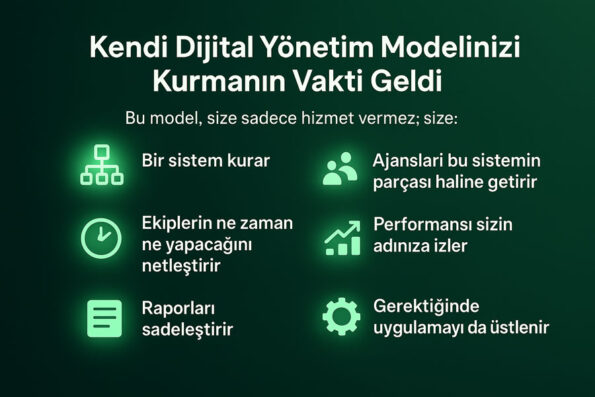
90-Day Digital Management Model Implementation Plan
The Digital Consulting Model starts this transformation process in 3 months. The first 90 days are ideal for strategy setup, team orientation, agency integration, and basic KPI tracking.
Phase 1 – Weeks 1–4: Analysis and Strategy
- Digital asset x-ray
- Team and resource map
- Agency business structure analysis
- Goal definition and KPI set
- Create a strategic digital roadmap
Phase 2 – Weeks 5–8: Implementation and Teaming
- Create a task matrix
- Distribute work to internal and external resources
- Website conversion optimizations
- Start a content and advertising calendar
- CRM and form configurations

